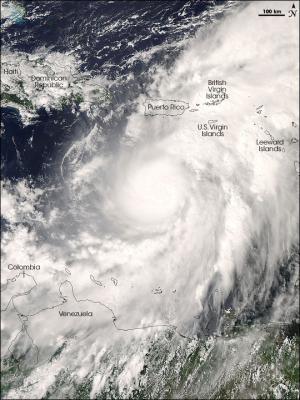Fresh Water Feeds Hurricanes' Fury
When hurricanes blow over ocean regions swamped with fresh water, the storm can unexpectedly intensify. According to a new study led by researchers at Pacific Northwest National Laboratory and published in the Proceedings of the National Academy of Sciences Early Edition, though the probability that hurricanes will hit these conditions is small – about 10 to 23 percent – the rate at which they intensify can be relatively higher when they do, by as much as 50 percent on average.
The research team looked at Omar, a Category 4 hurricane over the eastern Caribbean Sea in 2008. They found that regions of the ocean where there is a large influx of fresh water sets up conditions that form a layer between the surface and the colder ocean below, termed a barrier layer, preventing typical ocean mixing and cooling of the surface layer by strong winds. The most intense activity of Omar occurred when the storm traveled over this thick layer. The team then examined 587 tropical storms and cyclones between 1998 and 2007 in the western tropical Atlantic, the western Pacific and the northern Indian Oceans. They found that when tropical storms passed over thick ocean barrier layers, the storm cooled off 36 percent less than storms passing over areas lacking barrier layers, and barrier layer storms drew 7 percent more heat from the ocean than other storms. The team supported their analysis with a computer model, comparing tropical cyclones over regions with and without barrier layers.
Satellites are useful for tracking and helping to predict the path of tropical storms as they move across the ocean and develop into cyclones or hurricanes, as well as predicting where the storms will hit land. But current technology isn’t as good at predicting how intense the storm will be when it does hit land. This study provides new insight into the conditions that make these storms, which affect millions of lives around the world, more intense and destructive.
Researchers, led by DOE scientists at Pacific Northwest National Laboratory, found that tropical cyclones intensify, by up to 50 percent, when passing over ocean regions with a barrier layer. Using a combination of observations and model simulations, the team demonstrated that barrier layers, formed through high fresh water input reducing the salinity in the upper tropical oceans, significantly increase the intensity of tropical cyclones. When tropical cyclones pass over these regions, the increased stratification and stability within the layer reduce storm-induced vertical mixing and sea surface temperature cooling. This causes an increase in enthalpy flux from the ocean to the atmosphere and, consequently, an intensification of tropical cyclones. On average, the intensification rate is nearly 50 percent higher over regions with barrier layers, compared to regions without. Their finding underscores the importance of observing not only the upper-ocean thermal structure but also the salinity structure in deep tropical barrier layer regions. This distinction may be a key to more skillful predictions of tropical cyclone intensities through improved ocean state estimates and simulations of barrier layer processes. Improving a tropical cyclone’s forecast and mitigating its destructive potential requires knowledge of various environmental factors that influence the cyclone’s path and intensity. As the hydrological cycle responds to global warming, any associated changes in the barrier layer distribution must be considered in projecting future tropical cyclone activity.
This research was supported at PNNL by the U.S. Department of Energy (DOE) Office of Science, the Biological and Environmental Research (BER) Integrated Assessment of Global Change program for the Regional Integrated Assessment Modeling project and the BER Regional and Global Climate Modeling program for a collaborative project between PNNL and Texas A&M University. Additional support was provided to Texas A&M by the DOE BER’s Regional & Global Climate Change program, the U.S. National Science Foundation, the National Science Foundation of China, and the Chinese Ministry of Education. The work was performed by Drs. Karthik Balaguru and L. Ruby Leung of PNNL; Drs. Ping Chang, R. Saravanan and Jen-Shan Hsieh at Texas A&M; Zhao Xu at Texas A&M; and Dr. Mingkui Li at Ocean University of China.

